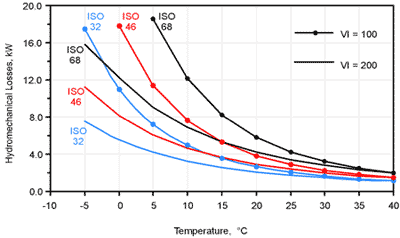Mark Kovalsky is right. Essentially, most hydraulic fluids used in automatic transmissions, tractor output drives, simple constant speed drives, and so forth, all benefit from having the fluid temp warmed up to between 5-deg F to 15-deg C (41-deg F to 59-deg F) at a
minimum to approach the "knee in the curve" and thus begin to realize substantial and measureable efficiency benefits as temp increases.
Here's an example with some different standardized grades of hydraulic fluid. Graph measures hydromechanical losses as a function of temperature, ISO Grade and VI (viscosity index):
Note that the gain in freedom from hydromechanical losses hits an asymptote as we approach 40-deg C (104-deg F). In short, it doesn't take much total temperature to get there. Once above 40-deg C, efficiency gains measured against temp increase are incrementally much smaller.
Essentially, once above 40-deg C, in general any further increase in hydraulic fluid temp for these generic hydraulic fluids doesn't net huge gains in efficiency. True that...to get into the "sweet spot" between volumetric efficiency (ability to pump the fluid) and not have your power transmission equipment lose a lot of input power to fluid circuit losses, you have to get the fluid warmed up. My thermostatic controls on our vans are fully open at 140-deg F, so that is one significant contributing factor to pretty good MPG on my old vans despite their advanced age. I like staying below 180-deg F, but I think the next time I install one of these ATF cooling setups on a newer vehicle (whatever I buy in the future), I'll probably use a Mishimoto inline thermostat with their 71-deg C (160-deg F) thermostat.
Automotive ATF's generally fall between 100 and 200 as far as the viscosity indexes go (the higher the number, the more "stable" the measured viscosity is against temperature change), so the above chart is a good starting point for understanding Mr. Kovalsky's spot-on assertion that very cold ATF temp squanders efficiency.
This is why I like the Tru-Cool LPD ATF coolers, and wish I'd installed one. They have the restriction-free plates that allow the bulk of cool ATF to flow without exchanging much heat, but once viscosity drops with increasing temperature, more ATF flow is evident within the rest of the cooler's bulk. This eliminates the need for a thermostat when using a properly sized cooler, according to the people at Long who make the Tru-Cool lineup.
On that note, I was climbing up a mountain highway one calm, sub-freezing morning into Wolf Creek in Colorado. I was driving carefully, and even with the stock Honda OEM ATF cooler, my datalogger was showing ATF outlet temp exceeding 200-deg F on our 2002 EX as we made it to our ski resort destination. The alarmingly hot Cajon Pass was on a later trip. Those experiences drove me to augment the ATF cooling loop with more robust equipment.
All Honda trannies are pretty small relative to what they're asked to do. The portion aside from the torque converter containing gearing and clutches and sump is about the size of a large gym duffel, even on the newest one. They warm up their ATF quickly when asked to transmit a lot of power. The van has always weighed in at about 2.2 tons since 1999.
OF
P.S. Man, I just cannot word this any better and in a more concise fashion.

 I thought I read around 180 degrees is normal and over 200+ hot and detrimental to fluid breakdown? Also purchasing a Scangauge to monitor.
I thought I read around 180 degrees is normal and over 200+ hot and detrimental to fluid breakdown? Also purchasing a Scangauge to monitor.




